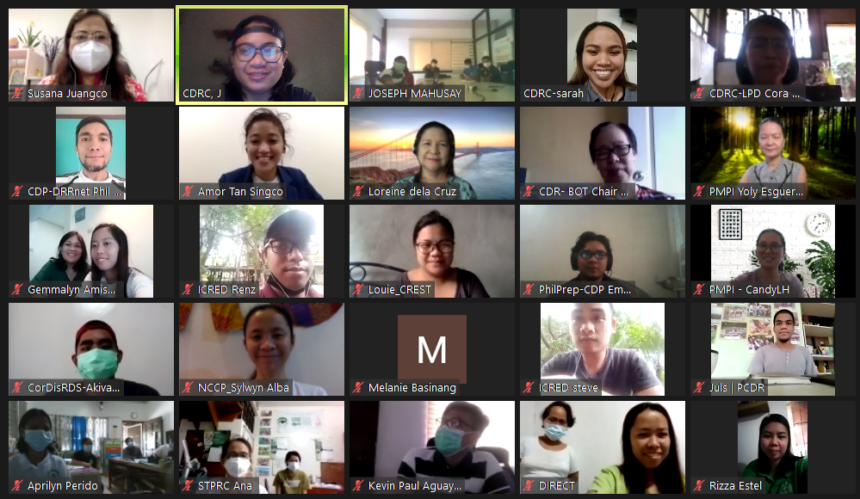CDRC conducts virtual tabletop exercise for the ‘Big One’
The Philippines frequently experiences seismic and volcanic tremors since it is located along the Pacific Ring of Fire, a vast Pacific Ocean region where a large number of earthquakes and volcanic eruptions occur. In recent months, we experienced a series of earthquakes that shook various parts of the country on top of dealing with the COVID-19 pandemic. These events could signify that the big one is probably coming, as the major Philippine fault lines have been disrupted. The “Big One” is a worst-case scenario of a 7.2-magnitude earthquake from the West Valley Fault, a 100-kilometer fault that runs through six cities in Metro Manila and nearby provinces.
As one of the staunch advocates of disaster preparedness, the Citizens’ Disaster Response Center Foundation Inc., in collaboration with DRRNetPhils held the first-ever online tabletop exercise (TTX) last February 23-24, 2021 on the response to the 7.2 magnitude earthquake in the National Capital Region. The TTX is also the flagship activity of the recently launched ‘UP for the Big One’ (Ugnayan para sa Paghahanda/United in Preparation for the BIG ONE) network of CSOs, which was also spearheaded by CDRC.
The said tabletop exercise is a major endeavor that aimed to test the response capabilities and preparedness of affected and assisting CDRN (Citizens Disaster Response Network) regional centers and select CSOs and LGUs should the 7.2 magnitude earthquake happen. It was also intended to assess the applicability of all the Emergency Preparedness Response Protocol s (EPRP) of all regional centers to this kind of event. The TTX proper was held on the first day wherein the players responded to various scenarios and injects using an online form. The scenarios used in the activity were based on the projections of the Metropolitan Manila Earthquake Impact Reduction Study (MMEIRS) and were adopted in the context of the pandemic. The audio-visual presentations of the scenarios amplified the reality as these provided the participants an idea of how the potential disaster can affect the entire Metro Manila enabling them to envision their role when the actual earthquake response happens. The TTX was participated in by 11 regional centers of CDRN, LGU officials from barangays Escopa III and Pansol, Center for Disaster Preparedness (CDP) and ECO WEB from DRRNetPhils, and NCCP and PMPI from faith-based organizations.
The evaluation process was done on the second day of the activity where evaluators shared their assessment of the participant’s responses to the given scenarios and inject. Experts from various government agencies including Training Specialist from CBTS (Capacity Building and Training Services) of the Office of Civil Defense (OCD), Ms. Rachelle Anne Miranda, Science Research Specialist, Ms. Charmaine Villamil of PHIVOLCS, two representatives from the Department of Social Welfare and Development (DSWD), Ms. Abigail Lorraine Antonio, Project Development Officer III, and OIC Division Chief of Preparedness for Response Division, Mr. Kristyan Harold Javier, and LDRMMO III-Chief of Research and Planning Section Ms. Ma. Bianca Perez, Dr. Irvin Miranda of Health Emergency Management Bureau, and Ms. Edna Conda Chief of Rehabilitation and Recovery Management Service (RMRS) of OCD-NCR served as the evaluators. They also participated in a dialogue to assess whether the responses to each given scenario were accurate and applicable in an actual earthquake situation. The evaluator Ms. Charmaine Villamil of PHIVOLCS, reiterated the importance of developing a response plan that is in line with the government’s strategic action for providing response assistance to manage earthquake and tsunami-related incidents. She also pointed out that there is a need to unify the CSOs’ plans with that of the local, regional, and national levels. The evaluator Dr. Irvin Miranda from the Department of Health also noted that in the national plan, there are categories of responders from adjacent regions wherein the CSOs, based on their clusters or services, can coordinate to maximize the resources. It is also important to validate the information to provide an appropriate response. He also added that responding to every disaster with good intentions is not enough and that we should all try to help and act appropriately.
Overall, the TTX was able to reach its objective of allowing each player/ organization to learn and clarify their roles, responsibilities, functions, plans and procedures in case of a 7.2 magnitude earthquake. Moreover, it helped to identify issues that require further planning. Regional centers were also able to identify gaps in their preparedness and response plans. With information and lessons obtained in this exercise, CDRN will now move forward to update its EPRPs to reflect the discussion and generate an appropriate response plan for the “Big One” in the different regions.

